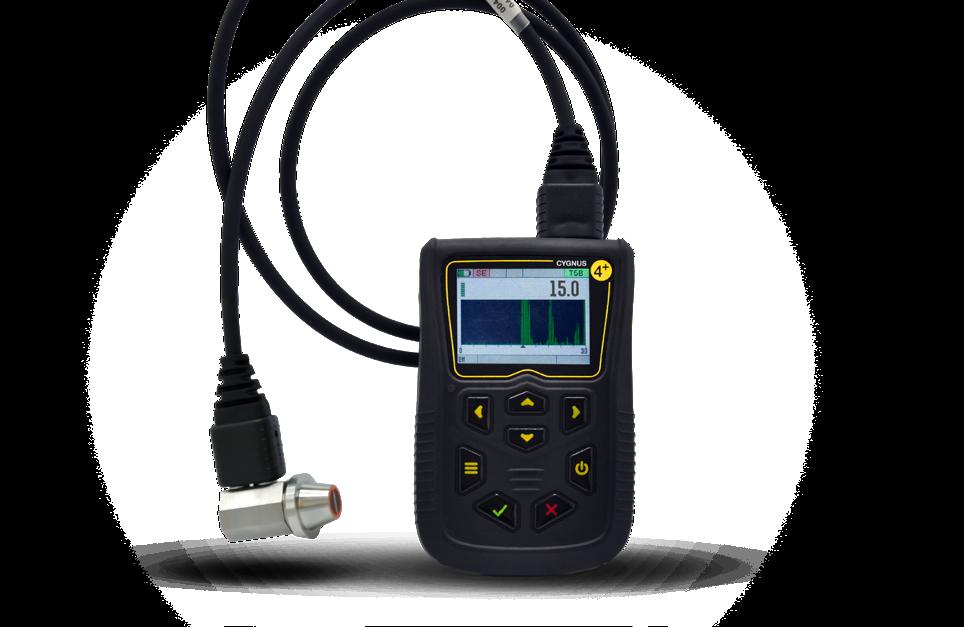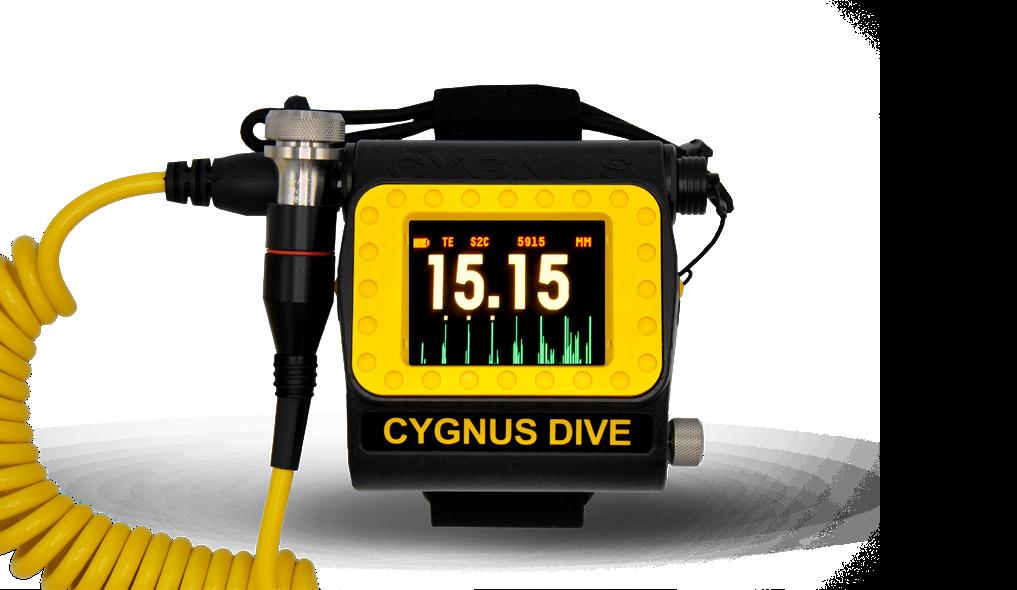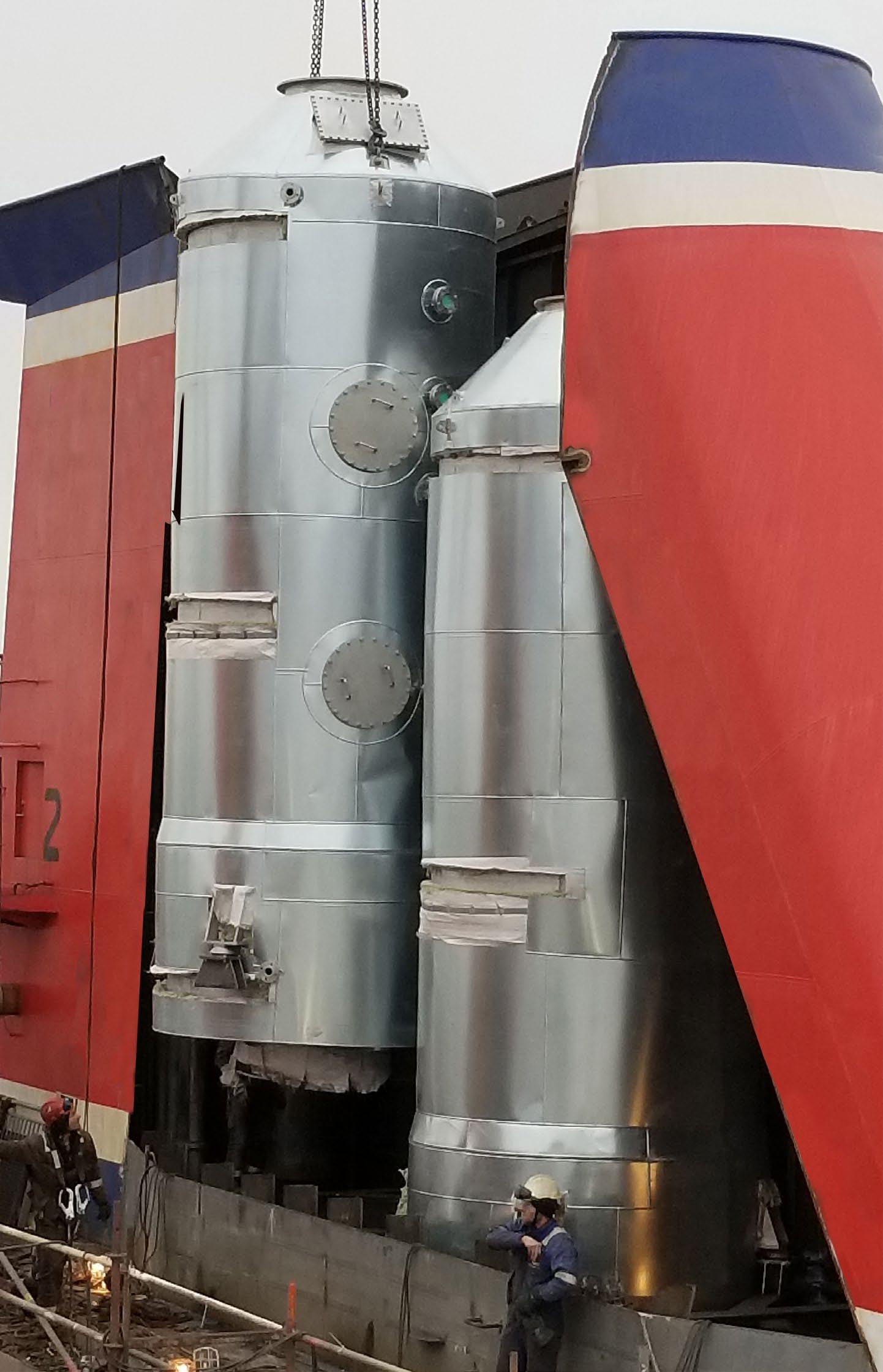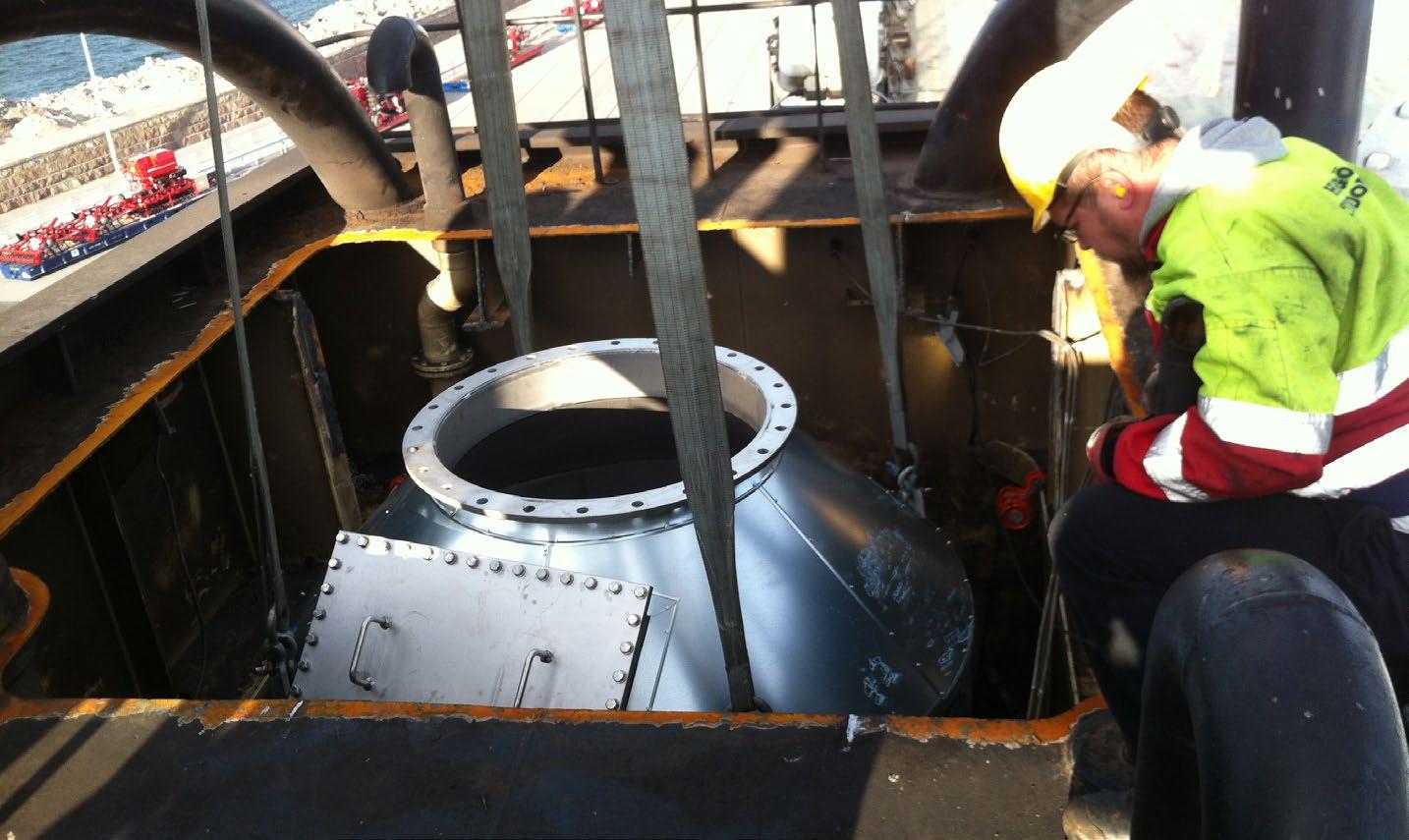
18 minute read
LEADING EDGE
from CSI Summer 2021
by Maritime-AMC
Two recent reports have shown LNG to be the clear favourite in the race to comply with IMO 2020 — but it isn’t all plain sailing
LNG IS HERE TO STAY
– FOR NOW
It has become pretty obvious over the past few months that LNG is the frontrunner — for the time being — in the race to comply with the International Maritime Organization’s (IMO) low-sulphur fuel edict, which became mandatory on 1 January 2020. This was despite a recent attack on the fuel by the World Bank, which promoted a rigorous response from the LNG lobbyists, most notably SEA-LNG.
Two reports both published in April seem to confirm this view and two classification societies have also produced figures showing the rise in the number of ships ordered stipulating LNG as a fuel.
However, the different fuel system lobbyists are still claiming that LNG will only be an interim fuel until something else is adopted ahead of the total ban on fossil fuels, while some pundits have queried the building of “LNG-ready” tonnage, saying that the cost of retrofits was prohibitive.
The reports — one researched by a leading UK broking house, the other by academic experts and commissioned by organisations with vested interests in LNG — said that the use of natural gas was continuing to grow, as was the infrastructure to back it.
Gibson Shipbrokers and DNV analysed the number of vessels either running on LNG or earmarked to operate on the fuel in the future.
There will always be exceptions to any rule and for LNG-fuelled vessels, this was no different. Fortescue Metal Group (FMG) decided to cancel a tender for 10 LNGfuelled 209,000dwt bulkers, which was only circulated earlier this year, in favour of ammonia-powered vessels.
While this is very far sighted of FMG, it will mean that it will have to wait until at least 2025 before a suitable engine is available, with actual vessel deliveries maybe several years after that, Gibson said.
Of course, the reason for this change of heart was purely commercial as FMG plans to build a green ammonia production facility in Tasmania, which will provide a new fuel source for the company.
However, Gibson pointed out that there were still a large number of companies
planning to build LNG-,fuelled vessels and importantly, don’t have an in-house renewable fuel supply.
As at the beginning of April, the LNGfuelled vessel orderbook stood at more than 130 confirmed vessels complete with dedicated IMO numbers. A few more have been ordered since. Another report suggested that 25% of vessels ordered in the first quarter of this year were LNG fuelled.
In the past, there was a diverse range of vessels ordered capable of using LNG. However, larger vessel types are now dominating the orderbook, with VLCCs, suezmaxes, aframaxes, large containerships and newcastlemax bulkers coming to the fore.
Tankers and bulkers are particularly suited to LNG propulsion, as the bunker tanks can be sited on deck, resulting in limited impact on the vessels cargo carrying capacity, Gibson explained.
Larger designs of container vessels (ULCVs) are being fitted with LNGfuelled engines, as their large capacities makes the loss of TEU capability less of an issue by installing an LNG tank on deck. However, smaller designs are seeing less of an uptake. For example, CMA CGM announced in March an order for up to 20 wide-beam conventionally fuelled panamax containerships fitted with scrubbers.
The company’s reasoning behind this was that the 5,000 TEU vessels will be too small to install LNG bunker tanks. CMA CGM already has experience with LNG on its larger vessels operating between Europe and Asia and is looking to introduce bio-products on some ships in its large fleet.
Of the 27 LNG-fuelled vessels ordered between January and the beginning of April this year, 14 were tankers, nine were containerships, with two general cargo and pure car carriers’ each. They will be built through to 2024, Gibson said.
In the tanker sector, ADNOC Logistics & Services has changed the propulsion specification for its VLCC newbuildings to a dual fuelled system that will use LNG.
The contract was placed late last year at Daewoo (DSME), and included an option for three more VLCCs. Each vessel was reported to have cost $86.7m. The addition of LNG fuel systems, is thought to add between $15-17m to the cost of each VLCC.
Shell recently ordered 10 LNG-fuelled VLCCs at DSME. In addition, Maran Tankers has four LNG-fuelled VLCCs on order at SHI, while Total has two LNGfuelled VLCCs placed at the same yard.
In the large drybulk sector, there was recently a spate of mining companies ordering or negotiating orders for new bulk carriers that will operate on LNG.
For example, Rio Tinto approached two shipyards in China to build up to 12 LNG-fuelled newcastlemaxes worth about $804m in total. Reports indicated that Qingdao Beihai Shipbuilding and New Times Shipbuilding were the preferred yards. To be built under the “Project Orion” banner, these vessels will transport ore between Australia and China and will be 210,000dwt. Their delivery dates were said to be from 2023 onward.
Logistics will need to be put in place to fuel these vessels. BHP was said to be partnering with Shell to fuel its newbuilding five newcastlemax LNG (208,000 dwt) bulkers chartered from Eastern Pacific Shipping (EPS) and ordered in mid-2020 from the New Times yard in China.
Anglo American has also taken four newbuildings (190,000dwt) ordered by U-Ming at Shanghai Waigaoqiao shipyard, which will be built under a 10year charter. These vessels are reported to have cost $65m each.
In addition, New Times recently announced that negotiations were in progress for four firm 210,000dwt bulkers, with an option for eight more, under the code name “Project Himalaya”.
Their scheduled delivery is anticipated from mid-2023. They will be powered by MAN’s MEGI engines and type-C LNG bunker tanks. At the time of writing, the identification of the vessels’ owners and charterers had not been released.
The current container vessel orderbook (with IMO numbers) contains more than 40 vessels fitted with LNGfuelled propulsion systems.
Of these, Hapag Lloyd has six 23,000 TEU vessels under construction at DSME, CMA CGM has four 22,000 TEU vessels, along with another nine 15,000 TEU vessels, on order at HHI. EPS has 10 newbuilding 14,800 TEU containerships also at HHI and has recently ordered another 10 ULCVs believed to be on the back of MSC charters.
Interestingly, EPS is also trialling ammonia on some of its ships and is also looking at hydrogen.
Despite a growing orderbook, the question that is becoming increasingly more difficult to find a definitive answer to is how long will it be before alternative fuels, such as ammonia, methanol and/or hydrogen become a reality and start taking market share from LNG in the newbuilding orderbook?
While hydrogen is seen as a nextgeneration fuel for shipping, the other fuels will potentially start to impact the shipping sector within this decade, Gibson said.
Like the move to LNG, the transition to new fuels will be based on vessel replacement and fleet expansion, meaning this could potentially take several decades for the fleet to move fully to renewable fuels.
In the meantime, LNG will continue to provide an alternative to conventional fuels in the medium-term.
SECOND REPORT
This brings us on to the second report, which was an independent study undertaken by Sphera, formerly Thinkstep, which was commissioned by SEA-LNG and the Society for Gas as a Marine Fuel (SGMF) and conducted under ISO standards.
It confirmed that greenhouse gas (GHG) reductions of up to 23% are achievable today from using LNG as a marine fuel, depending on the marine technology employed. The report compared the emissions of current oil-based marine fuels measured from well-to-wake (WtW).

CYGNUS 4+
GENERAL PURPOSE ULTRASONIC THICKNESS GAUGE

• Well-suited for corrosion inspections of scrubber
pipework • Multiple measuring modes ideal for extreme corrosion • Ignores coatings up to 20mm
CYGNUS DIVE
UNDERWATER ULTRASONIC THICKNESS GAUGE

• Ideal for in-water surveys of ships
• Depth rated to 300m/985ft • Data logging • Topside repeater option
QUOTE CSI2021 WITH ORDER
INTUITIVE, ACCURATE, DURABLE UTM GAUGES. GET A FREE QUOTE AT WWW.CYGNUS-INSTRUMENTS.COM OR CALL OUR TEAM TODAY ON +44 (0) 1305 265 533
This was the second Lifecycle GHG Emission Study on the use of LNG as a marine fuel and revisited the earlier 2018/2019 research work.
The analysis concluded that, in addition to the considerable air quality benefits it delivers, LNG can “beyond question” contribute significantly to the IMO’s GHG reduction targets.
Commenting on the research, SEALNG Chairman Peter Keller says: “The updated Sphera study ensures that the industry has access to comprehensive research that is fully up to date. It is clear that LNG plays an important role in de-carbonisation today with benefits available now.
“As we look ahead, it is essential that detailed emissions analysis from well-to-wake, such as those performed for LNG, are available for all alternative fuels contemplated, enabling shipowners to make the right decisions for their fleet,” he says.
Data was provided by original equipment manufacturers including Caterpillar MaK, Caterpillar Solar Turbines, GE, MAN Energy Solutions, Rolls Royce (MTU), Wärtsilä, and Winterthur Gas & Diesel, as well as from ExxonMobil, Shell, and Total on the supply side.
Methane emissions from the supply chains, as well as methane released during the onboard combustion process (methane slip), were included in the analysis. The report claimed that in five to seven years, methane slip could be reduced by as much as 90% on gas burning 4-stroke engines, while 2-stroke engines would see the highest benefit where methane slip was the lowest.
Keller explains: “Often based on outdated data, methane slip has become an overused argument for those wishing to justify inaction. The Sphera study underlines the advances being made to counteract this concern. Its analysis provides independent confirmation that, by 2030, methane slip will have been virtually eliminated as technological improvements continue.
“The facts consistently confirm that there is no deepsea alternative fuel in the short-to-medium-term other than LNG. LNG remains the clear starting point for a carbon-neutral future for shipping, especially as the pathway forward includes bio and synthetic products. Waiting is not an option. The industry must act now to capture the benefits that are clearly there for the taking by using LNG.”
COMPLEX CHOICES
Samir Bailouni, SGMF Chairman, adds: “It is important the industry has the best information to make often complex choices between fuels. This study provides authoritative, high-quality data on well-to-wake emissions for LNG.
“We are confident this work will provide IMO with solid information contributing to its regulatory decisions. SGMF will continue to provide up-todate data not only for LNG but for all candidate gaseous fuels under its remit, including ammonia and hydrogen.
“Today, the clear choice for an immediate and significant reduction in emissions is LNG, which is widely available and fully compliant with existing regulations. This is reflected in the rapidly increasing adoption of LNG in the deepsea container, bulk and tanker sectors, a trend we expect to accelerate even as the more challenging horizon
fuels are brought safely and sustainably into the mix,” he concludes.
The transition to bio and eventually synthetic LNG is straightforward, as the existing infrastructure and engine technology remain the same, the report said and the standards, guidelines and operational protocols are already in place. It also provides an asset base that can be used by other alternative fuels, when and if they become commercially viable.
Lack of infrastructure was the main argument used against the use of LNG in a sort of “chicken and egg” situation. Today there were around 20 LNG bunker vessels operating, up from just one in 2017 and another 35 on order, the report said.
For the use of alternative fuels, regulators need to set standards and goals going forward, rather than find solutions that might not work in the long run.
LNG UNDER ATTACK
However, the World Bank report The Role of LNG in the Transition Toward Low- and Zero-Carbon Shipping claimed that LNG was likely to play a limited role in the de-carbonization of the shipping sector, pointing to its specific niche applications on pre-existing routes or in specific vessel types.
The research recommended that countries should avoid introducing new public policy that supports LNG as a bunker fuel, reconsider existing policy support and continue to regulate methane emissions.
“The maritime community, particularly in developing countries, has a unique opportunity in the context of these emerging zero-carbon bunker fuels,” says Bernice Van Bronkhorst, World Bank’s Global Director for Climate Change. “Not only will they help decarbonise shipping, but they can also be used to boost domestic infrastructure needs and chart a course for low-carbon development more generally.”
“Zero-carbon fuels will need to represent at least 5% of the bunker fuel mix by 2030 to put shipping on a GHG trajectory consistent with the Initial IMO GHG Strategy, as well as the Paris Agreement’s temperature goals,” adds Binyam Reja, World Bank’s Acting Global Director for Transport. “This means they need to be scaled up rapidly. These reports will be critical to help accelerate their targeted development and deployment.”
The research makes the case that strategic policy interventions are needed to hasten the sector’s energy transition and seize opportunities for wider economic, energy and industrial development in developing countries.
For example, the introduction of a meaningful carbon price would create a level playing field for the development and utilisation of zero-carbon bunker fuels. Revenue generated by such a market-based measure can help support developing countries in their energy transitions and accelerate crucial research, development, and deployment of these fuels.
In response, SEA-LNG says waiting for future fuels and not fully utilising LNG, which is safe, proven, competitive and available today, was a mistake.
The World Bank’s recent report attempts to prescribe solutions and predict the timing of future technology development, SEA-LNG says, believing strongly that the transition to future fuels must not follow this prescriptive approach.
“By focusing on theoretical, unproven solutions, the World Bank stifles innovation in technologies that can also provide answers in the decades ahead. We strongly encourage all institutions around the globe that have a place in the policy debate to set standards and targets that drive real and immediate reductions in GHG emissions not prescribe specific technology solutions that are untried and unproven in the real world,” SEA-LNG says.
“To suggest that investments not be made in the LNG sector is unwise will prolong the use of higher emissions fuels and slow down shipping’s decarbonisation.
“Based on the primary data and methodology of SEA-LNG’s latest research, we are unequivocally confident that Sphera’s 2nd Lifecycle GHG Emission Study on the use of LNG as a Marine Fuel is the definitive study on the essential role that LNG has to play in shipping’s pathway to de-carbonisation.” IN CONCLUSION
While methane slip is an issue that needs to be addressed, its effect must be quantified using up-to-date and accurate information. Using current engine information, as the SEA-LNG study does, shows that methane slip does not impact LNG’s GHG reduction potential to the extent that the World Bank report claims.
LNG engine solutions are already in use today with minimal methane slip. Manufacturers are on a pathway to continue to reduce methane slip even further through measures which include design changes, and the implementation of advanced combustion algorithms.
The World Bank report also fails to acknowledge the very rapid acceleration in the availability of bio-LNG. The European Biogas Association expects a 10-fold increase in Europe by 2030 and, according to a study by the International Energy Agency (IEA), every part of the world has significant scope to produce biogas and/or biomethane, the gaseous form of bio-LNG.
The 2020 bio and synthetic fuels study by CE Delft highlighted that largescale bio-LNG supplies produced from sustainable biomass resources could be available in the 2030s, presenting the maritime sector with a safe and scalable alternative fuel.
While highlighting green ammonia and hydrogen as the only viable future fuels, the World Bank report failed to mention the major challenges associated with these fuels. Considerable research and development, as well as extensive operational testing, is still needed.
Major technological and regulatory hurdles need to be overcome before ammonia and hydrogen can be safely used as fuels in the marine environment. The massive investments that will be required in new infrastructure will have to be co-ordinated with shipowners and other stakeholders.
The World Bank’s untested theoretical approach risks delaying the shipping industry’s decarbonisation and, at worst, it can lead the industry down a technology cul-de-sac, SEA-LNG warns.
CROE: SCRUBBERS FOR CLEANER SEAS
As in days of old, when every ship arriving to port would be met by joyous crowds, the shipping world is excitedly watching the return of activity — from cargoes to cruise ships, ferries, RORO and all other vessel types in between.
This is bringing renewed focus on the key problem facing shipping: protecting the planet while continuing to operate at a profit.
To reduce sulphur emissions, the MARPOL convention implemented a series of restrictions that went into effect in two stages: 1 January, 2015 and 1 January, 2020. The MARPOL mandate basically provided shippers with three compliance alternatives: » Change fuel » Purchase premium fuel » Continue using high sulphur fuel in conjunction with maritime exhaust gas cleaning systems, also known as marine scrubbers. As scrubbers allow ships to burn far less expensive fuel and also avoid some of the compatibility and other issues associated with the new low sulphur fuels, the growing consensus is that the use of scrubbers is the best choice: burn the fuel you want, operate the ship as you always have, meet MARPOL compliance and save money on every refueling.
CROE® Scrubbers reduce a ship’s sulphur (SO2) emissions to a level that meets both the 0.1%S or the 0.5%S ceilings, even when content of bunker fuel is 3.5%S or higher. Additionally, scrubbers are proven to have a significantly lower CO2 footprint than using low sulphur fuels and also achieve lower sulphur emissions than even low sulphur fuels, as well as benefiting from lower particulates emissions — and all at a lowercost.


CR Ocean Engineering scrubber installation
WHAT WE OFFER
CR Ocean Engineering (CROE®) develops in-line, u-type, and side-entry scrubbers. Each are available in three standard configurations, customisable to a ship’s specific requirements: » Open-loop (hybrid ready): once-through scrubber using sea water. » Closed-loop: a recirculating scrubber using freshwater with caustic. » Hybrid: a combination of both designs for maximum flexibility. CROE scrubbers normally replace the silencers. However, they can also be installed after or in parallel with the silencer. Due to their small size, compact design and flexibility of operation, CROE Systems are perfect for both new-builds and retrofits.
Some of the features of the CROE Scrubbing Systems include: » Option of bottom entry in-line, u-type, and side-entry scrubber designs to better fit any funnel configuration and simplify engine exhaust gas duct with or without a bypass. » Strategically configured exhaust gas inlet and scrubber drainage to eliminate any potential water backflow to the engine. » Eliminated circulation water storage from bottom of scrubber vessel to a separate tank at a lower elevation to reduce weight at the higher elevations, improving stability. » Alloy construction (external and
internal) to extend the life of the system and to allow the exhaust gas to travel through the scrubber system at high temperatures in case of dry-run conditions without a bypass. » Used proprietary internals designed specifically to increase contact area with lower liquid flows to save on typical pumping costs associated with some scrubber designs. » Proprietary Caustic-Assist™ feature for open-loop assist operating in low alkalinity areas. As the recovery unfolds, at CROE we’ll continue helping our clients to speed up yard work to reduce overall process. To this end, we introduced our “side entry” and “Venturi designs”, allowing for greater prefabrication prior to the ship arriving at the site.
Furthermore, recent studies by CE Delft and the independent Norwegian research organisation SINTEF confirm that burning high-sulphur fuel oil with a scrubber has a lower carbon footprint than using low sulphur fuel oil (LSFO). With the increased emphasis on global warming, this is a very positive benefit.
So, an increase of LSFO production worldwide can actually create more damage in the long run than cleaning the emissions via a scrubber.
Additionally, when using marine gas oil (MGO) or LSFO, the emissions of particulate (soot) are still an issue. It has been shown in studies that the particulate from MGO and LSFO is even more dangerous than that from heavy fuel oil because it is finer and penetrates the lungs deeper. HFO, in combination with a properly designed scrubber, will not have such issues. The problem with emission of soot and SO2 is with human lungs and not the sea.
STATE-OF-THE-ART APPROACH
Building on our successful deployment of scrubbing technology for SO2 and PM, CROE engineers are hard at work seeking to improve our offering by developing state-of-the-art approaches to remote monitoring and controls, scrubber water treatment and a significant reduction of black carbon and fine particulates (<PM2.5) and CO2 emissions.
CROE has established a number of strategic alliances around the world to allow it to extend its applications to reduce fine particulate control (PM2.5), CO2 and water pollutants.
Most recently, CROE partnered with Oberlin Filter to provide an easilyintegrated washwater filtration system to remove sludge in a non-hazardous dry form, streamlining the process to discharge extremely clean water filtrate back in the body of water. This approach also greatly reduces the cost of sludge disposal.
The World Shipping Organization notes that the shipping industry “more than any other, makes it possible for a truly global economy to work. It connects countries, markets, businesses and people, allowing them to buy and sell goods on a scale not previously possible. And as consumers, we have become used to seeing goods from all parts of the globe readily available in the stores we visit.”
It is very possible to do it without leaving a mess in the process.
For more information, contact: Nick Confuorto, CROE® President and COO Tel: +1 (973) 455-0005 ex 110 Email: nconfuorto@croceanx.com croceanx.com










